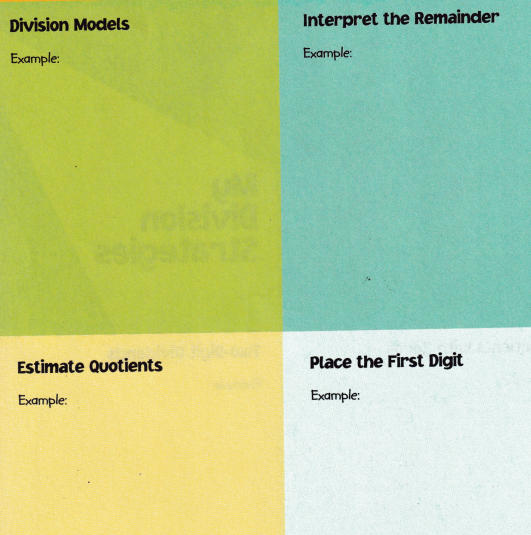All the solutions provided in McGraw Hill My Math Grade 5 Answer Key PDF Chapter 3 Divide by a One-Digit Divisor will give you a clear idea of the concepts.
McGraw-Hill My Math Grade 5 Answer Key Chapter 3 Divide by a One-Digit Divisor
Essential Question
What strategies can be used to divide whole numbers?
Answer:
Strategies like an area model, using the relationship between multiplication and division, or using partial quotients.
Explanation:
Area model strategies,

Partial Quotients strategy.
The divisor is multiplied with a number and the multiple obtained is deducted from the dividend.

Am I Ready?
Multiply.
Question 1.
12 × 7 = ___
Answer:
84
Explanation:

The two factors and the product are parts of a multiplication.
the numbers 12 and 7 are the factors, while the number 84 is the product.
Question 2.
42 × 8 = ___
Answer:
336
Explanation:

The two factors and the product are parts of a multiplication.
the numbers 42 and 8 are the factors, while the number 336 is the product.
Question 3.
51 × 9 = ___
Answer:
459
Explanation:

The two factors and the product are parts of a multiplication.
the numbers 51 and 9 are the factors, while the number 459 is the product.
Question 4.
7 × 18 = ___
Answer:
126
Explanation:

The two factors and the product are parts of a multiplication.
the numbers 18 and 7 are the factors, while the number 126 is the product.
Question 5.
3 × $75 = ___
Answer:
$225
Explanation:

The two factors and the product are parts of a multiplication.
the numbers 3 and 75 are the factors, while the number 225 is the product.
Question 6.
3 × $89 = ___
Answer:
$267
Explanation:

The two factors and the product are parts of a multiplication.
the numbers 3 and 89 are the factors, while the number 267 is the product.
Question 7.
Turner’s bookshelf has 6 shelves. Each shelf has 17 books. How many books are on the bookshelf?

Answer:
102 books.
Explanation:
Turner’s bookshelf has 6 shelves.
Each shelf has 17 books.
Number of books on the bookshelf,
17 x 6 = 102
Round each number to its greatest place value.
Question 8.
36 ___
Answer:
40
Explanation:
When rounding to the greatest place value,
The greatest place value is tens.
So, round up to the nearest tens of the given number..
If the number to the right is more than 5 then the greatest place value goes up by one.
36 is rounded up to 40.
Question 9.
$451 ____
Answer:
$500
Explanation:
When rounding to the greatest place value,
The greatest place value is hundred.
So, write the nearest hundred of the given number.
If the number to the right is more than 5 then the greatest place value goes.
$451 is rounded up to $500.
Question 10.
7,449 _____
Answer:
7,000
Explanation:
When rounding to the greatest place value,
The greatest place value place value is thousand.
So, write the nearest thousand of the given number.
If the number to the right is less than 5 then the greatest place value goes down.
7,449 is rounded down to 7,000.
Question 11.
$33,103 ___
Answer:
$30,000
Explanation:
When rounding to the greatest place value,
The greatest place value place value is ten thousand.
So, write the nearest ten thousand of the given number.
If the number to the right is less than 5 then the greatest place value goes down.
$33,103 is rounded down to $30,000.
Question 12.
$271 ____
Answer:
300
Explanation:
When rounding to the greatest place value,
The greatest place value place value is hundred.
So, write the nearest hundred of the given number.
If the number to the right is more than 5 then the greatest place value goes down.
$271 is rounded up to 300.
Question 14.
There are 7,209 students at the amusement park. To the nearest thousand, how many students are at the park?
Answer:
7,000 students.
Explanation:
There are 7,209 students at the amusement park.
Number of students at the park are 7,000.
The nearest thousand of 7,209 is 7,000.
Divide.
Question 15.
8 ÷ 2 = ___
Answer:
4
Explanation:
Take the first digit of the dividend from the left.
Then divide it by the divisor and write the answer on top as the quotient.
Subtract the result from the digit and write the remainder.
Division is the opposite of multiplication in mathematics.

Question 16.
15 ÷ 3 = ___
Answer:
5
Explanation:
Take the first digit of the dividend from the left.
Then divide it by the divisor and write the answer on top as the quotient.
Subtract the result from the digit and write the remainder.
Division is the opposite of multiplication in mathematics.

Question 17.
27 ÷ 3 = ___
Answer:
9
Explanation:
Take the first digit of the dividend from the left.
Then divide it by the divisor and write the answer on top as the quotient.
Subtract the result from the digit and write the remainder.
Division is the opposite of multiplication in mathematics.

Question 18.
28 ÷ 4 = ___
Answer:
7
Explanation:
Take the first digit of the dividend from the left.
Then divide it by the divisor and write the answer on top as the quotient.
Subtract the result from the digit and write the remainder.
Division is the opposite of multiplication in mathematics.

Question 19.
48 ÷ 6 = ___
Answer:
8
Explanation:
Take the first digit of the dividend from the left.
Then divide it by the divisor and write the answer on top as the quotient.
Subtract the result from the digit and write the remainder.
Division is the opposite of multiplication in mathematics.

Question 20.
54 ÷ 9 = ___
Answer:
6
Explanation:
Take the first digit of the dividend from the left.
Then divide it by the divisor and write the answer on top as the quotient.
Subtract the result from the digit and write the remainder.
Division is the opposite of multiplication in mathematics.

Question 21.
Three people spent a total of $24 for lunch. If they divided the total cost equally, how much did each person pay?

Answer:
$8
Explanation:
Three people spent a total of $24 for lunch.
If they divided the total cost equally,
Each person has to pay $24 ÷ 3 = $8
My Math words
Review Vocabulary
compatible numbers multiples place value product
Making Connections
Use the review vocabulary to complete the concept wheel.
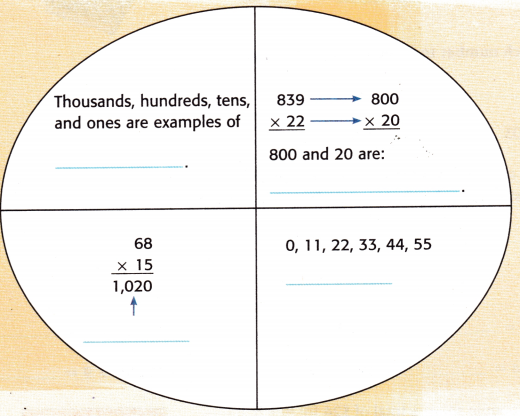
How can these vocabulary words help you solve multiplication problems?
Answer:

Explanation:
Thousands, tens, hundreds are the place values of a number.
Compatible numbers are the numbers that are easy to add, subtract, multiply, or divide.
Also, these numbers are close in value to the actual numbers,
that make estimating the answer and solving problems easier.
For instance, if we multiply 839 and 22, we get our answer as 18458.
compatible numbers of 839 is 800 and 22 is 20, we get 17,600.
When we multiply any two numbers we get the product.
for example; 68 x 15 = 1,020.
Multiples of 11 are 0, 11, 22, 33, 44, 55, 66 and so on..
My Vocabulary Cards


Ideas for Use
- Work with a partner to name the part of speech of each word. Consult a dictionary to check your answers.
- Draw or write examples for each card. Be sure your examples are different from what is shown on each card.
The number that divides the dividend.
Answer:
Divisor.
Explanation:
24 ÷ 3 = 8
24 is dividend.
3 is a divisor.
8 is the quotient.
Write 3 division problems that have 2-digit dividends and 1 -digit divisors. Circle each divisor.
Answer:
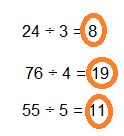
Explanation:
24, 76 and 55 are the two digit dividends.
3, 4 and 5 are one digit divisors.
8, 9 and 11 which are circled are the divisors.
A dividing method which the dividend is separated into addends that are easy to divide.
How can you use place value when using partial quotients?
Answer:

Explanation:
Partial Quotients strategy.
The divisor is multiplied with a number and the multiple obtained is deducted from the dividend.
The number that is left after one whole number is divided by another.
Write the letter used to represent remainder.
Answer:
R (Remainder)
Explanation:
The number that is left after one whole number is divided by another is known as remainder.
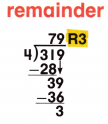
A letter or symbol used to represent an unknown quantity.
Answer:
X
Explanation:
42 ÷ 6 = x
6 x 7 = 42
x = 7
X is the symbol used to represent an unknown quantity.
The Latin root var means “different. Explain how this helps you understand the meaning of variable.
Answer:
A variable is an alphabetic character that expresses a numerical value or a number.
In algebraic equations, a variable is used.
Explanation:
4 x K = 32
k = 32 ÷ 4
K = 8
A number that is being divided.
Answer:
Dividend.
Explanation:
24 ÷ 3 = 8
24 is dividend.
A division problem has a divisor of 12 and a quotient of 7. What is the dividend?
Answer:
84
Explanation:
To find the dividend multiply the divisor and quotient, we get dividend.
12 x 7 = 84
A group of related facts that use the same numbers.
Write a set of numbers that are a fact family. Explain why they are a fact family.
Answer:
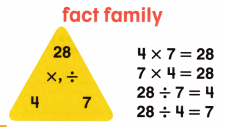
Explanation:
A fact family is a group of math facts or equations that use the same numbers.
A fact family in math can show the relationship between the numbers as shown above.
The result of a division problem.
Which review word is also the result of an operation on numbers?
Answer:
Quotient.
Division is the opposite of multiplication.
Explanation:
24 ÷ 3 = 8
8 x 3 = 24
A missing value.
50 divided by an unknown number is equal to 5. Find the unknown number.
Answer:
10
Explanation:
Lett the unknown number be x.
50 ÷ x = 5
x = 50 ÷ 5
x = 10
My Foldable
Follow the steps on the back to make your Foldable.

Foldables Study Organizer
